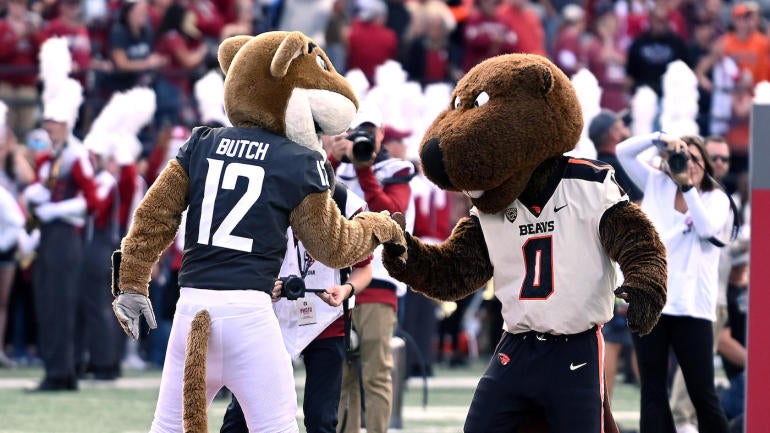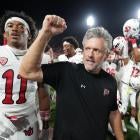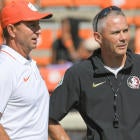
On Jan. 8, the morning of the 2024 College Football Playoff National Championship, the commissioners and conference presidents who oversee the organization (known as the CFP Management Committee) met in Houston to finalize what was thought to be a formality. The goal: address the final access point for the expanded 12-team playoff field starting next season.
In the wake of realignment and the demise of the Pac-12, it has been thought that the 6+6 model would become a 5+7 model with the number of conference champion automatic qualifiers decreasing from six to five. (The four highest-ranked such teams would receive byes into the second round.)
"I would be shocked if we don't have a 5-7 playoff," said CFP Board of Managers chairman Mark Keenum, president at Mississippi State, on that day. "The Pac-12 Conference has asked to wait a couple of weeks."
Four weeks later, there has been no movement on the issue, and there really isn't a Pac-12, either. What's left of the conference -- Oregon State and Washington State -- might as well be considered the "Pac-2." The plucky leftovers from the Pac-12 asked to delay the vote during that Jan. 8 meeting.
The two schools -- battered and bruised after being left out in conference realignment -- could essentially control the CFP on any issue going forward over the next two years. All CFP decisions must be made unanimously through the end of the current media rights contract, which concludes after the 2025-26 playoff.
As a result, less than 11 months until the 12-team playoff kicks off, the CFP is once again stuck in the mud. It helps the Pac-2 cause that Washington State president Kirk Schulz just happens to be the Pac-12 representative on the board.
"What I know for certain is that Kirk wants to use that vote for leverage," said a source close to the Pac-2. "Kirk Schulz has the Pac-12 vote, and he effectively has a veto vote."
That indicates this entire process is hardly the formality it was once thought to be. But the question becomes, to what end are Schulz and the Pac-12 attempting to wield their leverage? Keenum said four weeks ago the two schools had "legal issues" to work through.
Schulz is apparently seeking "voting rights" and revenue assurances going forward, Yahoo Sports reported Sunday.
The CFP Management Committee convenes Monday and Tuesday in regularly scheduled meetings.
Schulz did not reply to a request for comment.
For two schools facing an uncertain future, holding onto that vote like a life raft in a hurricane is certainly about money. Here's why it's about money …
That extra spot in the playoff is worth a lot. Research shows that the additional at-large berth is most likely to be filled by an SEC or Big Ten school. The Group of Five has already voted to support a 5+7 model figuring a reduction of automatic qualifiers was inevitable anyway. The original 6+6 model was based on the "Power Five" concept. With the Pac-12 gone, it's now a Power Four with the ACC and Big 12 alongside the SEC and Big Ten.
"I think [Schulz] just sitting on his vote trying, at the end of the day, to get a little more money from the CFP," said an industry source with experience in such negotiations. "He's not a fire-thrower guy. He's made it clear that he thinks that he and Oregon State need a little something special."
The Pac-12 athletic departments need the boost. Washington State is 53rd nationally in revenue ($85 million), while Oregon State is 54th ($83 million), according to USA Today's database. That puts them in the upper half of the FBS but near the bottom in their old conference. It also helps explain why the pair need financial assurances now so they can continue running major-conference athletic departments while figuring out their futures.
Oregon State and Washington State will make an estimated $35 million in the final full Pac-12 media rights payout before the league officially ends July 1. After that, the schools will fight to maintain their standard of living. The pair will split what the San Jose Mercury News estimated to be $260 million (from a period of multiple years) in NCAA Tournament units owed to the Pac-12 along with Rose Bowl payouts and settlement money from the 10 schools that left the league.
However, significant liabilities are still attached to the Pac-12 brand that will reduce that incoming revenue. The 12 league schools are still on the hook for monies owed to former partner Comcast ($72 million) and potentially the Holiday Bowl (at least $3 million in a lawsuit). There is also a decision to be made on Kliavkoff, who has three years left on his contract and no conference to oversee.
"We're inching toward a settlement," said one Pac-12 source close to the situation.
For the next two years, the Pac-2 are in a limbo of quasi-independents involved in a scheduling agreement with the Mountain West. One of the few certainties the next two years is that each will make approximately $5 million annually in CFP disbursements.
Beginning in 2026, everything is on the table, including (potentially) the size of the playoff itself. Do Schulz and the Pac-2 have enough leverage to get certain considerations beyond the end of the contract? "The goal was always just to buy some time," said another source close to the plight of the two schools.
The pair can shore up their finances by joining a new conference. The ACC and Big 12 are the most desired options. Florida State's aggressive attempt to exit the ACC is garnering particular attention. What once looked like a process that would unfold over 7-10 years now may only take that many months. If FSU is somehow able to extricate itself from the ACC, the conference would be destabilized to the point that California and Stanford could help assemble some form of the old guard Pac-12 segment on the West Coast. While not geographically desirable candidates for the Big 12, the programs continue to hold out hope.
As everything stands at the start of 2024, it is largely assumed Oregon State and Washington State will more permanently align with the Mountain West -- in whatever form that might take -- beginning in 2026.
"We recognize there is going to be a point we have to make a decision … If we can't get into one of the two [power] leagues then it's going to be either building out a league or doing something with the Mountain West," said a source involved with the discussions who was not authorized to speak publicly.
They may need to buy in to a new subdivision. NCAA president Charlie Baker proposed in December a new subdivision that would cost an estimated $5 million to $7.5 million annually per school to establish a trust fund for players. That could be a way for Oregon State and Washington State to remain among the upper crust of college football regardless of their conference affiliation.
"If this new subdivision is 'buy your way in,' that's actually good news for OSU and WSU," said a person familiar with the ongoing discussions. "They may not be able to generate the money. [But they think], 'You want to play in this new subdivision, you've got to go find [$7.5] million bucks somewhere.'"
Every Power Four schools must to make budgetary plans for the House v. NCAA lawsuit, a potential landmark case. OSU and WSU were original defendants in that suit when the Pac-12 existed. The resulting liability could be massive. Damages in House could total more than $4 billion if the jury finds for the plaintiffs.
The Pac-12 also remains part of a National Labor Relations Board complaint that seeks to turn college athletes into employees. What liability will there be if the NLRB rules in favor of the athletes within the next two years and players have to be paid directly by schools? With no certainty on how stressful such a decision would be on athletic budgets, more money helps create more certainty for Oregon State and Washington State.
The CFP is close to signing a new eight-year deal with ESPN worth $1.3 billion annually, sources confirmed to CBS Sports. That figure would mark the largest media rights deal for a college sports property in history. It is nevertheless below what the CFP initially expected for its expanded rights, according to industry sources.
"You always want more, whatever the number," Keenum said.
It is becoming evident to the industry that first-round games will not be worth what was once projected. (If the 12-team playoff was in effect last season, No. 5 Georgia would have played No. 12 Liberty in a first-round game; that looks and feels like a mid-September nonconference matchup with the favorite naming its score.)
Those first-round games may have originally been valued at $25 million each in the marketplace, one source told CBS Sports. Their value is now seen as around $5 million each, depending on the matchup.
In their current state, do Oregon State and Washington State add any value (or even subtract some) from the contract?
Adding to the Pac-2's consternation: What share of that $1.3 billion are the SEC and Big Ten going to demand? It's almost certain that the two most powerful conferences going forward will seek a weighted split of that revenue. They all but made that clear on Friday.
That only creates more uncertainty for Oregon State and Washington State.
So how much, exactly, is their one vote worth?





















